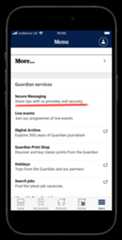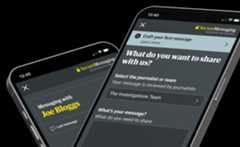How to contact the Guardian securely
How to contact the Guardian securely

Some of the most important stories published by the Guardian have comefrom confidential tips. If you have something sensitive toshare with us, here’s how to get in touch.
Confidential tips
Journalists work closely with readers like you to investigate storiesin the public interest. While no communication system is foolproof wego to great lengths to protect your identity. If you’re ready to share information with a journalist, you’re in the right place, and we will treat you as a confidential journalistic source.
We rely on people sharing tips in the public interest – and we’regrateful that you’re thinking about getting in touch.

Composing your message
We’re unlikely to pursue a lead unless we think it may lead to a newsstory, and we can't act on information that is vague or speculative.Our job is to hold power to account, to reveal institutional orsystemic failings and to report on topics that are genuinelynewsworthy. Please be clear, detailed and specific about your tip, whyyou think it matters, and what evidence you have.
Facts: Specifics are critical, such as names,locations and dates.
I work atgovernment department ‘Department name’ in the procurement section.
Clearly state the nature of your tip: Be concise and focus on what you know, rather than what you think or suspect.
I have discoveredevidence of a senior official's involvement in corruption and bribery. ‘Name’, the head of our section, has received $150,000 in under-the-radar payments.
Evidence: Tell us how you know what you know,and how we might verify it.
I havephotographic evidence of transactions from the past two years and access tofurther documents that show these were a quid pro quo for awarding contracts to multinational company ‘Company name’.
Choose your contact method
There are many ways to contact the Guardian securely. Review thefollowing options to see which one is best for you.


SecureMessaging
Share your story with a journalist.
Securely & easily. Inside our news app.
- Free and easy to download.
- End-to-end encrypted.
- Sending messages is indistinguishable from normal use of the Guardian app.
- Connects you, anonymously if you choose, directly to our journalists.
- Designed to be easy for everyone to use, without expert tech knowledge.
- If you live or work in a place where the Guardian app is not safe tohave on your device, scroll down for alternative ways to contact us.



SecureDrop
Our SecureDrop system is a great way to contact us and to send documents. However, it does require more technical preparation.
Pros:
- SecureDrop does not record where things come from.
- All material is encrypted automatically.
- We read your submissions on secure computers.
Cons:
- You will need to download Tor software to access our SecureDrop system.
- If you are being watched, the very act of using Tor may arouse suspicion.
SecureDrop allows you to safely send us messages and documents, and to followup with us later if you wish. All we get is what you send us plus a codenamethat allows us to reply to you. SecureDrop records nothing else about you. Toprevent interception at our end, we decrypt any material that you send us on a system that is completely offline.
Get started:
On a computer that you are confident is not being monitored, installTor Browser. Then go to theguardian.com/securedrop and follow the instructions there.
After that:
When you first visit our SecureDrop site itself, you will be given a passphrase before you can send anything. This phrase allows you to log back in to view replies from us and to continue correspondence, if you so wish. We do not always reply to messages and even when we do, responses can take several days.
SecureDrop is quite a slow way to communicate, so after you have beguncorresponding with a reporter they may suggest a more direct way to interact.You don’t have to agree to this, of course, but it can make things smootherunder some circumstances.
SecureDrop is an open source project managed by theFreedom of the Press Foundation.
Instant messenger apps
End to end encrypted messaging apps such as Signal and WhatsApp provide good protection for the content of your messages, and are very easy to use.
Signal is trusted by journalists, human rights activists and security expertsworldwide, and is our recommended instant messaging app. WhatsApp, while not quite as secure, also encrypts the content of communications and benefits from being so ubiquitous that using it is unlikely (in itself) to raise suspicion in most parts of the world. Other secure messenger apps tend to be less widely used for communication between sources and our journalists.
Pros:
- They’re very easy to use.
- They allow for speedy back-and-forth communication.
- Everything is encrypted in transit and on the service providers’ servers, sonot even they can read the content of your messages.
Cons:
- On WhatsApp, information about the participants in a conversation is lesssecure than the content itself.
- There are ways for very sophisticated adversaries, such as government spy agencies, to ascertain that someone is communicating with a journalist using messaging apps – even if they can’t read the message content.
- Instant messenger communication requires advance knowledge of theparticipants’ contact details. For WhatsApp it must be a phone number; forSignal it can be a username or phone number. Many journalists are reluctantto publish their personal contact details widely because such information can be abused.
It’s not uncommon for conversations with journalists to shift to instant messengerapps once both sides have established some trust and have discussed thebenefits and risks. But you or the journalist may decide not to use them.
Get started:
Decide whether you want to do this on your normal phone or on a less easily traceable phone. After installing the app, make it as secure as possible: if there are extra authentication options, activate them. And activate disappearing messages so your conversations don’t sit around forever on your device.
Read more about Signalhere and about WhatsApphere.
After that:
If you’re worried about surveillance and you’ve not used the app before,consider using it for few innocuous purposes first, such as exchanging messages with friends. That way, when you message us, your use of the app doesn’t look out of the ordinary.
Signal/WhatsApp numbers for our investigations teams:
- United Kingdom: +44 7721 857348
- United States: +1 646 886 8761
- Australia: +61 490 758 250
Please don’t call or send ordinary text messages to those numbers. You won’tget a reply.
Check our journalists’ profile pages for other contact details.Google their name and ‘the Guardian’ and you should find them. If you can’tfind the right contact details for the journalist, you could message one ofthe above numbers and ask for your details to be passed on to the person youhave in mind.
Please note the recommendations earlier in this guide for what to say about the information you wish to share.
Use a tailor-made email account to make it less obvious that you are in contact with a journalist.
If the information you wish to share with us isn’t extremely sensitive, email is probably the easiest way to get in touch. Even so, you may consider it worthwhile to put a bit of distance between your messages to a journalist and the rest of your life. Plus, because journalists receive so many emails, you should take extra care to make sure your message doesn’t get lost in the noise.
Pros:
- Everyone knows how to use email, and many Guardian journalists publishtheir email addresses.
- You can send long messages and attachments. This is difficult using phoneapps.
- It's possible (but not straightforward) to add encryption to email messages.
Cons:
- Normal emails are not at all secure. Your correspondence can be monitored. Even a purpose-built email account can reveal information about you.
- Adding encryption to emails is difficult and does not hide some information(who is talking to whom, the subject lines, etc).
Email is an inherently insecure medium but you can do some things to make your correspondence less likely to be intercepted.
Get started:
Don’t use your regular work or personal email address. Create a new email account solely for corresponding with the Guardian. Do this on a computer that can't easilybe linked back to you.
When you sign up for a new email account, make sure the sign-up information you provide doesn’t tie the account back to you. Never use the same password for different accounts.
After that:
Because it's so easy to send emails, journalists often receive a lot of spuriousand irrelevant messages. So anything that doesn't get their attention quickly may be overlooked. Read the advice further up in this guide about what makes a good story tip.
Information carried with an email message can reveal your IP address. If you don’t want the location you send from to be traceable, connect to your email service over the Tor network. or send from somewhere that doesn’t easily identify you.
Remember to log out after sending the message. You may also wish to delete the history of the correspondence from your browser or email software. Keep your computer secure.
Some Guardian journalists publish PGP keys, allowing you to encrypt the contentof email messages (but not the subject line or the fact that you are communicating with them).Seetheguardian.com/pgp.
- You can email the Guardian's UK investigations team on investigationsno.thanks.contact@thenot.here.eitherguardian.com.
Telephone
Although telephone communication is far from secure, it can be a practical way to get a conversation started.
Pros:
- Requires no technical prowess.
- Useful to initiate communication with a journalist to exchange contactinformation for more secure channels.
Cons:
- Telephone communication can be intercepted and could reveal your identityand/or location.
- It’s not always easy to verify that the person you’re speaking to is whothey say they are.
Get started:
Before you get in touch, find the name of the journalist you want to speak to,and decide in advance exactly how much you want to tell them about who you areand how they can get back to you. The journalist you want may not be availablewhen you call, so you may have to leave a message. Be prepared for that.
If you plan to share documents with us later, look at some of the otheroptions in this guide before calling so you can tell the journalist how you’dprefer to do that.
Consider whether or not it is safe to call us from your work or home phone, orfrom any mobile phone that is associated with you. If you buy a pay-as-you-gosim card to call us from a new number, think carefully about where and whenyou buy it, and how you pay for it. And remember that mobile phone callsdisclose the handset ID as well as the sim card.
After that:
Call us on one of these numbers:
- London office: +44 (0)20 3353 2000
- Sydney office: +61 (0)2 8076 8500
- New York office: +1 212 231 7762
- Washington office: +1 202 517 89042
- San Francisco office: +1 415 919 5874
Postal mail
Post still has its uses, especially if you want to send us hard copies.
Pros:
- If appropriate measures are taken, conventional mail can be a reasonablygood way to hide who you are.
- If you don’t want to meet a journalist in person, it’s the only reliable wayto hand over physical objects.
Cons:
- It’s slow.
- Post can get hijacked or at least scanned in transit.
- Post can get lost.
If you’re not actually being followed it’s fairly unlikely that an envelope orsmall package will get intercepted.
Get started:
Stuff can go missing in the post, so consider how bad it would be to lose thematerial you’re planning to send us. Can you make copies?
Think about whether or not you need to preserve your anonymity. Could theposting location give you up? How about the materials and packaging? If you’revery worried about the package being traced back to you, post it somewherebusy and make sure there is nothing memorable about your or the package’sappearance.
Mail is scanned for dangerous compounds and objects. Don’t include anythingthat could cause problems with delivery. International mail needs a customsdeclaration, and registered mail requires you to provide sender details.
After that:
- Guardian UK postal address:
The Guardian
Kings Place
90 York Way
London N1 9GU
United Kingdom - Guardian US postal address:
The Guardian
315 West 36th St
New York
NY 10018
USA - Guardian Australia postal address:
The Guardian
Level 2
19 Foster St
Surry Hills
NSW 2010
Australia
Still can’t decide?
Guardian software developers and journalists built the Secure Messagingtool in our app specifically to help people speak to our reporters assecurely as possible. We recommend you use it if you live and work in aplace where it is safe to use the Guardian news app.

Not what you were looking for?
Are you looking for other ways to contact us?
This page is about ways to contact Guardian journalists about issues thatyou think we should report on. It’s not for customer service enquiries,complaints, article pitches, etc. Try instead our standardcontact uspage. If you’re looking for help with your account, visit ourHelp Centre.
Want to support fearless, independent journalism? Please consider doing sohere.

